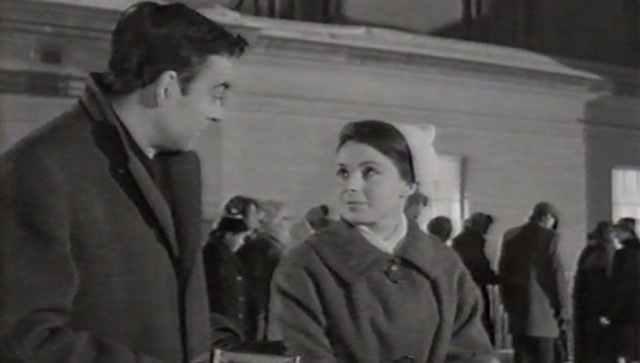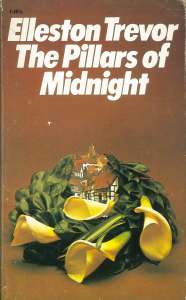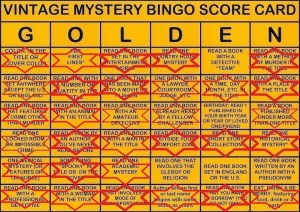This book was one of the first of a new breed of medical thrillers dealing with threats at the microscopic scale, spawned by anxieties over germ warfare (and which can be said to have peaked with Michael Crichton’s The Andromeda Strain). The time is the 1950s and the place is Kingsbourne. A young couple, a doctor and an ex-nurse, have to deal with marital stresses during an increasingly desperate effort to contain a deadly outbreak of smallpox, the resolution to which may lie in an old friend who threatens their marriage.
This review is offered for Todd Mason’s Tuesday’s Overlooked Film meme at his fab blog, Sweet Freedom; and Bev’s Vintage Mystery Challenge.
“There were fourteen red flags on the map now. It looked like a field in Flanders”
Trevor Dudley-Smith (1920–1995) was a highly prolific author who published adventure stories and crime fiction under nearly a dozen bylines. Highly popular in his day, he is best-known today for the ‘Quiller’ series of espionage novels he wrote as Adam Hall (and which I previously profiled here), though he probably got his best reviews for some of the more mainstream efforts he published as by ‘Elleston Trevor’ such as The Flight of the Phoenix, which was filmed twice. The Pillars of Midnight was also filmed – as 80,000 Suspects – and deserves to be better known.
“Have you ever been in contact with anyone from the east of Suez?”

Steven and Julie Monks have been married for eleven years and have two little boys (who are currently away on holiday). Their marriage seems to have stalled, leading him a few years ago to have a one-night fling with Ruth Preston, the wife of a colleague at the hospital where he works. They are desperate for a holiday, but it is possible that he is looking to get away from his marriage too. On the day of their departure for Cornwall he is called for a consult at the hospital and he discovers that the patient is dying of smallpox. He still wants to go away on leave but Julie, who used to be a nurse, insists on staying in case volunteers are needed, leading to a bust up between the couple. As the health authorities move into action to discover who the original carrier was (it turns out to be the son of the first victim), they try to track all his movements from the previous three weeks and vaccinate the entire town. Then Julie is struck down by the virus, which brings into focus a surprising religious dimension in the shape of the understanding Father McGuire (who is not beyond a little low humour) and the unyielding Catholicism of Dr Preston. The thriller aspects, leading to an extended manhunt for the final carrier, is well handled, as are the little vignettes relating to the families of the victims, though the family drama at its centre can be a bit soapy at times. It is a melodrama, but an unusual one and the mystery and manhunt aspects are unusual and very well done, as always with this author.
“What have you been crying for?”
“Dear life.”
In adapting the book, Val Guest took the fictitious ‘Kingsbourne’ setting and changed it to Bath and shifted the time from Summer to Winter, the story now beginning on New Year’s Eve. Using the heightened newsreel semi-documentary style he had employed with great success since The Quatermass Xperiment back in 1955, the film always looks great thanks to the great CinemaScope lensing of Arthur Grant that artfully combines studio settings at Pinewood and plenty of location filming, giving it a strong, realistic feeling (the production may indeed have been spurred to action by a real smallpox outbreak in Bradford in 1962). The adaptation is extremely faithful to the novel, using most of its dialogue, characters and situations.

There is one major change however, with Ruth, an integral character who is referred to and heard on the phone but who we never actually meet, now appearing on screen and played by Yolande Donlan. She was Guest’s wife and often appeared in his films. On the whole, one wishes he hadn’t given her the role as she is rather miscast. Always adept at comedy, she is easy to accept as a ditsy dypso, driven to drink by a stuffy, decent, passionless husband but rather less successful as a tragic, Dior-encased sexual predator torn by deep passions (it doesn’t help that she looks so much older than Johnson, though in fact he was only seven years her junior).
“… the constables and the night-shift foremen and ambulance crews, the men at the switchboard in the telephone exchange and the watchmen … These were the pillars of midnight who held the world steady in the dark.”
The rest of the cast is first-rate, with Cyril Cusack very understated as Father McGuire, while Johnson and Claire Bloom make for a very attractive pair as the tormented leads who, until the very end, never truly seem at ease with each other (intriguingly, although Ruth is given as the main thorn in their side, in both the book and the film, we are not quite sure what malaise it is that so plagues them). Incidentally, this was the first of two film that Johnson and Bloom co-starred in that year, the other being Robert Wise’s superbly atmospheric The Haunting. The two would be reunited again in later years, first in a 1982 TV production of Cymbeline (Bloom was the Queen to his King) and then in the 1992 mini-series The Camomile Lawn as the belatedly united lovers Oliver and Sophy. The film does feel dated in lots of ways, from its emotional restraint (to contrast with the deadly scenario) to its plot contrivances which tie everything up very neatly (the rather flat-footed and pat closing coda is much too brief). But none the less, this is a film that didn’t want for ambition within a fairly commercial product and with its good cast is well worth a look.
Val Guest (1911-2006)
This was the last of an impressive run of films made by Val Guest. He would keep working successfully for another 20 years, both on film and on TV, but nothing he produced came close to the films he had made in the 8 years beginning with his breakthrough hit, The Quatermass Xperiment (1955), which led to two fine collaborations with writer Nigel Kneale, Quatermass II and The Abominable Snowman (both 1957). He then continued with the musical Expresso Bongo (1959), an adventurous refashioning of the hit stage play, while the controversial war film Yesterday’s Enemy (1959) and the hard-nosed Manchester policier, Hell is a City (1960) both starred Stanley Baker. His 1962 Brighton-based thriller Jigsaw is too little-known and review is coming to Fedora next month). His career probably peaked with the low-key SF masterpiece, The Day the Earth Caught Fire (1961), which had a big impact on 80,000 Suspects. The two not only share much of the same technical crew and use the same understated, journalistic style (Arthur Christiansen plays a newspaper editor in both too), but also have a crucial scene in which the protagonists fall into each other’s arms after a ritual cleansing, both of which pushed at the barriers of censorship at the time but seem incredibly tame today.

DVD Availability: The film is now available on DVD and Blu-ray from Network, having not been previously released on DVD. I’m very glad to be able to retire my old TV recording which was not in proper widescreen. The film is also available to rent online in the UK via the BFI Player. Various clips are also available to view at the TCM website. The Blu-ray looks really great with a brand new transfer supervised by the BFI and also has a substantial booklet with in-depth liner notes by Neil Sinyard who compares the book and the film very seriously and in-depth.
80,000 Suspects (1963)
Director: Val Guest
Producer: Val Guest
Screenplay: Val Guest
Cinematography: Arthur Grant
Art Direction: Geoffrey Tozer
Music: Stanley Black
Cast: Claire Bloom, Richard Johnson, Yolande Donlan, Cyril Cusack, Michael Goodliffe, Mervyn Johns, Kay Walsh, Norman Bird, Basil Dignam, Arthur Christiansen
I submit this review for Bev Hankin’s 2015 Golden Age Vintage Mystery Challenge bingo in the ‘crime other than murder’ category:




The book sounds really intriguing, Sergio. A well-written medical thriller, especially one that’s plausible, can be very compelling. But I know exactly what you mean about miscasting actors. I wish in this case that hadn’t happened. Still, it’s good to know that in a lot of ways, the film has stayed very faithful to the book. We cranky old purists appreciate that…. 😉 Thanks as ever for the fine review.
Thanks Margot – the book and the film are pretty much in sync really and both have the similar virtues and deficiences – well worth visiting 🙂
The novel sounds very interesting, Sergio. You may have covered this before, but I was unaware that the author of the Quiller novels also wrote as Elleston Trevor. When I can whittle down my TBR pile a bit, I will look into those books. I do have The Quiller Memorandum (book and film) to try first.
Thnaks Tracy – the Quiller books are great favourites of mine so I think you’re definitely doing the right thing!
I’m very fond of Trevor Dudley-Smith’s work, both as Elleston Trevor and more especially as Adam Hall (under which name I’d propose he wrote the best of all the spy novels way back then: even the weaker Quillers outclass, in my opinion, the best Bonds, and I still read/reread them every now and then). When I was maybe 18 or 20 he and I had mutual friends; in my youth I was too stupid to make the effort to meet him — by all accounts he was an interesting man.
Thansk for that John – he was apparently a lot like the chararcters in his fiction, very much his own man and does sound like a fascinating character. On the other hand, I’m betting you know too many authors already 🙂
I’ll be getting this film when the next Network sale comes round – already picked up a significant number of releases that way – so it’s good to hear you’re generally pleased with it.
Never read the book though, and that Pan edition looks lovely, but you know how keen I am on those covers.
Wish I had that one – sadly I have the rather duller NEL edition at the top … The Blu-ray is very good (the BFI did the restoration) and the booklet is really decent
Can’t complain about the quality of any of Network’s recent releases, and it’s good to hear the booklet is worthwhile too. Such a lot of interesting stuff coming from them.
I’m just glad that they are out there and there is clearly a market for it. Especially considering that this Rank film han not ever had a release on disc before.
yes, lots of debut material on offer, and usually looking good too.
I know and I just spotted they the Michael Powell / Gordon Harker comedy thriller, THE PHANTOM LIGHT which seems to have arrived out of the blue.
Like the sound of both the book and the film! Val Guest made some great films, and I’d really like to revisit “Jigsaw” soon – it’s too long since I’ve seen it!
Thansk Karen. Review of Jigsaw (and of course the original novel) due in about 3 weeks
You uncover such forgotten corners Sergio! The name Elleston Trevor, and the Quiller series, both ring bells. The film sounds more attractive to me than the book.
Thansk Moira – but are good, solid entertainments with a touch of seriousness.
How is it that you always manage to come up with a book/film duo that I’ve never heard of, Sergio? Well, Yvette, it hasn’t been that difficult since you are not the film maven you thought you were.
Yeah, but…
No buts about it, kiddo, you know zip about movies.
Hey bud, I’ve forgotten more about movies than you’ll ever know.
Yeah, that’s the problem, chummy.
Yvette reboots the computer, sure that somehow something was said which she misconstrued. HA!
Another interesting post, kiddo. Don’t know about the book so much, but I’ve always liked films of this sort.
Yvette my friend, I’m actually rather sorry that seems to have turned out to be such an obscure title! But hey, Tuesday has rather become the day for obscure movies and books – I’m just sorry you’re doing fewer movie posts these days (you’re the one who put me in touch with Todd you know 🙂 ) Good health!
Yvette, that is the funniest comment ever. You are a very clever writer. My husband suffers from not being able to remember all the movies he thought he knew all about too. I am the one who never knew about them.
That was supposed to be “the funniest comment ever.”
All fixed Tracy!
Thanks, Sergio.
The very least I could do 😉
I’m just Yvette is on our side 🙂
Sergio, I’d be keen to read the book rather than see the film. I have not read Crichton’s THE ANDROMEDA STRAIN but I did read Robin Cook’s OUTBREAK, about the outbreak of a deadly virus in America. Turns out it was Ebola (I refreshed my memory just now) and Cook wrote his novel in 1987. Who would have thought his story almost came true. Thanks for writing about Val Guest’s films.
Thanks Prashant, my pleasure. It seems that very few people read Trevor / Hall today, which i hadn;t really understood. Shame really. Very interesting about Cook – I remember liking COMA a lot.
Pingback: SLEEP LONG, MY LOVE (1959) by Hilary Waugh | Tipping My Fedora